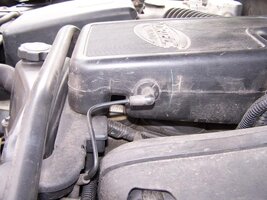- Aug 25, 2012
- 955
Hey GMT members, as usual I have another fun one. For the past 2 days my truck has been smelling of gasoline in the cabin. The exhaust smells like normal and there is pressure that builds up if I were to cover the exhaust with my hand for a second or 2 and then release it so it doesn't seem to be a cracked or broken exhaust. I opened my hood and checked for smell and with the engine off I couldn't really smell anything from either side. With the engine running I can smell gas on the passenger side, it is really strong if I get into the passenger wheel well.
I checked the sending and return fuel line that attaches on the drivers side of the engine at the top and they look fine. I couldn't really follow the line though that well to see if it has a leak on any other part of the line. I did not check the fuel trim on a scan tool to see if it is doing anything with my engine but will check this out tonight when I get out of work. The truck runs perfect at idle, WOT and normal cruise speeds of 30-65mph.
Can anyone give some insight on what to look for when I dig into it tonight? I might not be able to do it all tonight with it being in the single digits but I can try.
edit: I did check the gas cap and it is on tight. This did start happening after I fueled up on the 31st but I have a half tank of gas. I will check my fuel regulator tonight when I get home too. It starts just fine too and has no long crank time so I am thinking the fuel regulator is okay.
I checked the sending and return fuel line that attaches on the drivers side of the engine at the top and they look fine. I couldn't really follow the line though that well to see if it has a leak on any other part of the line. I did not check the fuel trim on a scan tool to see if it is doing anything with my engine but will check this out tonight when I get out of work. The truck runs perfect at idle, WOT and normal cruise speeds of 30-65mph.
Can anyone give some insight on what to look for when I dig into it tonight? I might not be able to do it all tonight with it being in the single digits but I can try.
edit: I did check the gas cap and it is on tight. This did start happening after I fueled up on the 31st but I have a half tank of gas. I will check my fuel regulator tonight when I get home too. It starts just fine too and has no long crank time so I am thinking the fuel regulator is okay.


 I tried to lookup envoy and trailblazer fuel pressure regulator and had 0 videos or anything showing how it was done, only the service manual showing the whole rail dis-assembly process of removing the intake manifold and everything which I know is unnecessary for the FPR. Thank you so much for finding that video!!!
I tried to lookup envoy and trailblazer fuel pressure regulator and had 0 videos or anything showing how it was done, only the service manual showing the whole rail dis-assembly process of removing the intake manifold and everything which I know is unnecessary for the FPR. Thank you so much for finding that video!!! 
 BTW.
BTW.